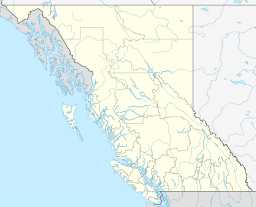Cache Creek, British Columbia
| Cache Creek | |
|---|---|
| Village | |
| Village of Cache Creek[1] | |
 Location of Cache Creek, British Columbia | |
| Coordinates: 50°48′50″N 121°19′36″W / 50.81389°N 121.32667°W | |
| Country | Canada |
| Province | British Columbia |
| Region | Thompson Country |
| Regional District | Thompson-Nicola |
| Incorporated | 1959 |
| Government | |
| • Type | Elected village council |
| • Mayor | P. A. John Ranta |
| • Governing body | Cache Creek Village Council |
| Area | |
| • Total | 10.25 km2 (3.96 sq mi) |
| Elevation[2] | 396 m (1,300 ft) |
| Population (2011) | |
| • Total | 1,040 |
| • Density | 101.5/km2 (263/sq mi) |
| Time zone | PST (UTC−8) |
| • Summer (DST) | PDT (UTC−7) |
| Area code(s) | 250 / 778 / 236 |
| Highways |
|
| Website | Town website |
|
| |
Coordinates: 50°48′43″N 121°19′24″W / 50.81194°N 121.32333°W
Cache Creek is a historic transportation junction and incorporated village 354 kilometres (220 mi) northeast of Vancouver in British Columbia, Canada. It is on the Trans-Canada Highway in the province of British Columbia at a junction with Highway 97. The same intersection and the town that grew around it was at the point on the Cariboo Wagon Road where a branch road, and previously only a trail, led east to Savona's Ferry on Kamloops Lake. This community is also the point at which a small stream, once known as Riviere de la Cache, joins the Bonaparte River.[3]
The name is derived, apparently, from a cache or buried and hidden supply and trade goods depot used by the fur traders of either the Hudson's Bay Company or its rival the North West Company.[4] Although it was first incorporated as a Local District municipality with the name Cache Creek in 1959, the name has been associated with this community since long before incorporation. A Cache Creek post office was first established here in 1868.[5]
Although still very active with traffic, Cache Creek was extremely busy for a few decades before the Trans-Canada Highway was superseded by the newer and shorter Coquihalla Highway, which bypasses the Fraser and Thompson Canyons between Hope and Kamloops via Merritt, about 97 kilometres (60 mi) southeast.
The nearby fossil locality, the McAbee fossil beds, is noted for the wide diversity of Eocene plants and animals preserved in the shale, including the extinct plants Dillhoffia[6] and Trochodendron drachuckii.[7]
The village of Cache Creek is also served by a community television station (run by the Ash-Creek Television Society), CH4472 in the neighbouring town of Ashcroft on VHF channel 4 (with an effective radiated power of 74 watts at 15 meters above ground level), with a repeater (CH4473 on VHF 8, with an effective radiated power of 49 watts at 45 meters) in Cache Creek, British Columbia. The town is also served by CFMA-FM 105.9, a tourist information station run by the Ash-Creek Television Society.

References
- ↑ "British Columbia Regional Districts, Municipalities, Corporate Name, Date of Incorporation and Postal Address" (XLS). British Columbia Ministry of Communities, Sport and Cultural Development. Archived from the original on July 13, 2014. Retrieved November 2, 2014.
- ↑ http://bccommunities.ca/Home/City%20Profiles/Thompson%20Okanagan/Cache%20Creek BC Communities.ca
- ↑ Akrigg, Helen B. and Akrigg, G.P.V; 1001 British Columbia Place Names; Discovery Press, Vancouver 1969, 1970, 1973, p. 35
- ↑ "Cache Creek (creek)". BC Geographical Names.
- ↑ "Cache Creek (Village)". BC Geographical Names.
- ↑ Manchester, S.; Pigg, K. (2008). "The Eocene mystery flower of McAbee, British Columbia". Botany. 86: 1034–1038. doi:10.1139/B08-044.
- ↑ Pigg, K. B.; Dillhoff, R. M.; Devore, M. L.; Wehr, W. C. (2007). "New Diversity among the Trochodendraceae from the Early/Middle Eocene Okanogan Highlands of British Columbia, Canada, and Northeastern Washington State, United States". International Journal of Plant Sciences. 168 (4): 521. doi:10.1086/512104.
